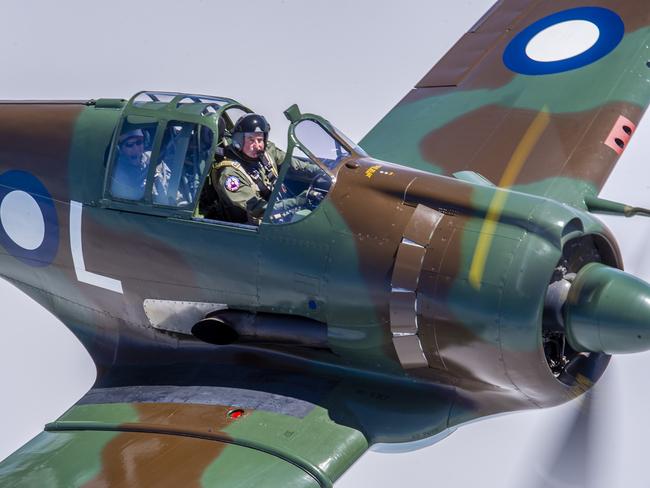SA Weekend cover story: Meet Jim Whalley, the ex-RAAF fighter pilot on a mission to rescue an economy shot down by coronavirus
Jim Whalley was an air force squadron leader who flew F/A-18 Hornets. He’s now trying to bring life to a state economy that has been shot down by the coronavirus.
SA Weekend
Don't miss out on the headlines from SA Weekend. Followed categories will be added to My News.
- Read more great features from SA Weekend
- Redeem these great rewards with your Advertiser+ subscription
When Jim Whalley was thinking about leaving the air force back in 2000, he was reasonably confident about his chances of picking up a decent job.
He was leaving the air force to move to Adelaide to be with his soon-to-be wife, Melinda O’Leary.
And with the natural-born confidence and ego of someone whose last job was flying F/A-18 Hornets at ridiculous speeds, he just thought there’d be a clamour for his services. Adding to his confidence was that he’d completed a Master of Business Administration through Adelaide University. He also had a physics degree. Whalley, full of optimism, asked his MBA professor, “Who is going to give me a job?”
The answer wasn’t the one he expected. “He said, ‘No one because all you are capable of doing is shooting aeroplanes out of the sky and dropping bombs on people’.” Which sounds a little harsh. Being a fighter pilot isn’t exactly a job for dummies after all. Still, Whalley was a lifer in the RAAF up until that point. His father, Alan Whalley, had been a fighter pilot in World War II and since Jim Whalley was five years old it was all he wanted to do. He joined the air force straight out of school and it was all he had known since.
The MBA professor wasn’t all doom and gloom, however. The course had included a component on entrepreneurship and Whalley had submitted a theoretical business plan that revolved around a private company providing engineering support to the military. And like most plans dreamt up in uni, it was promptly filed on the shelf.
But now the professor was asking, “Well, was it true, or did you make it all up?”
Whalley told the professor he had been serious and that he thought the plan was feasible. The professor’s next suggestion was that he should try to start that company.
On a flight to the RAAF base at Williamtown, in NSW, Whalley threw the plan over to Peter Nikoloff, a flight test engineer at the RAAF’s Aircraft Research and Development Unit. He thought it looked pretty good and agreed they should give it a crack. They named the company Nova Systems and 20 years later it has 600 staff and revenue of more than $200 million a year. It is Australia’s largest privately owned defence company. Whalley is now also SA’s official chief entrepreneur.
Not that it was easy. “Whilst I had an MBA I think it’s fair to say I didn’t know anything about business,” Whalley says.
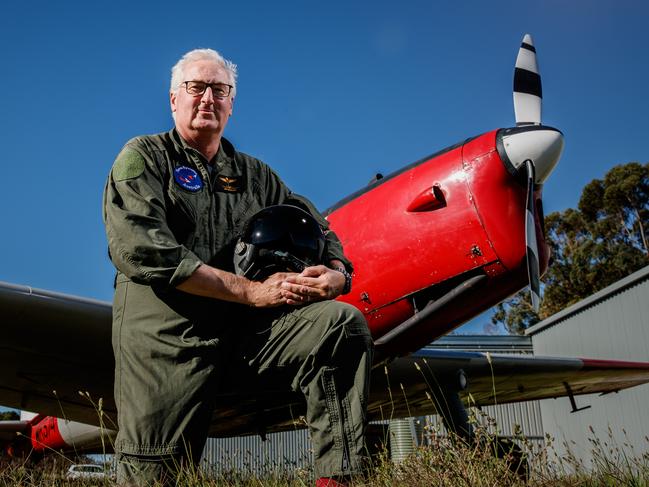
Now 53, Whalley is a gregarious sort. He likes a chat, especially if it involves aircraft and, as the previous line demonstrates, he has a nice line in self-deprecation. His office at Nova is a testament to all things aviation. Even climbing the stairs to his second-storey office at Mile End, you have to pass a glass cabinet with dozens of model aircraft. “Most people have pictures of their children; I have pictures of helicopters in my phone,” he says.
Whalley was only nine when his fighter pilot father died. Flight Lieutenant Alan Whalley had flown Boomerangs, Kittyhawks and Mustangs during World War II. He was part of 84 Squadron based at Horn Island in the Torres Strait, off the northern tip of Queensland, flying over New Guinea with the mission to intercept Japanese aircraft.
Jim Whalley has limited memories of his father, who was also Lord Mayor of Melbourne for two years until 1974. Alan Whalley was only 55 when he died from cancer of the oesophagus, but his godfather, Geoff Cuzens, who also flew in the war, told Jim stories of those times. Cuzens also helped look after the family when Alan died. They were tough times.
“When dad died he didn’t leave mum in a great financial state,” he says. Whalley says his mum Patricia, known as Paddy, “made some pretty major sacrifices to make sure my brother and I continued to be educated”.
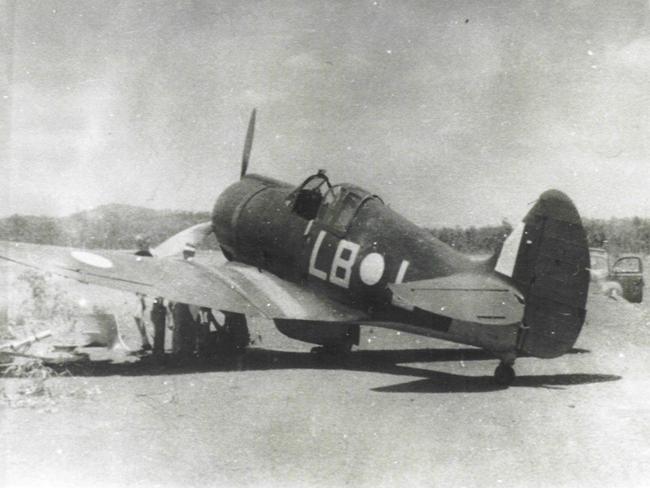
Whalley went to Geelong Grammar, an upmarket school which has taught the likes of media owner Rupert Murdoch, Australia’s next head of state, Prince Charles, singer Missy Higgins and prime minister John Gorton. From Geelong Grammar, Whalley went to the RAAF College at Point Cook, then the Defence Force Academy at Duntroon, graduating in 1986, before starting pilot school. His first job as a pilot was flying the Caribou, a short takeoff and landing cargo plane, which lasted two years, before heading to fighter school.
By 1992 he was flying the F/A-18 Hornet, then the top machine in the air force with a top speed of more than 2000km/h. Whalley tries to explain the sensation of flying such a beast. He says there is firstly the physical sensation. Those G-forces pinning you back in your seat.
Then, he says, there is joy.
“You are ploughing through the air at close to the speed of sound and it’s just absolute freedom. You are up there at 30 or 40,000 feet just by yourself.”
He reaches for poetry to describe it better, citing a work called High Flight by Canadian flyer John Gillespie Magee, who was killed in World War II.
The poem reads in part:
“Oh! I have slipped the surly bonds
of Earth
And danced the skies on laughter-
silvered wings;
Sunward I’ve climbed, and joined
the tumbling mirth
Of sun-split clouds – and done a hundred things.”
“Other times it’s just sheer adrenaline,” Whalley says. “You are at 150 feet doing 540 knots (1000km/h) and everything is going past and you are getting the weapons systems right and tracking targets, and it’s like your head is on fire because of all the stuff you are doing.”
It’s an expensive business, flying Hornets. They cost about $40,000 an hour to run and, given Whalley did 1000 hours on them, that adds up to about $40 million worth of flying. He even flew the Hornet during its annual appearance at the Adelaide 500 car race. There the trick was to go slowly, but not too slow.
“It’s pretty easy when you have speed, but when you are doing the slow pass, all the planning was that if you had an engine failure at that sort of speed, you had to have enough speed to get out of there,” he says.
“If you are right back, right back on the edge, you can put yourself in a situation where you are going to go downhill and it’s going to take you 500 feet to recover. And if you are at 500 feet you are going to hit something.”
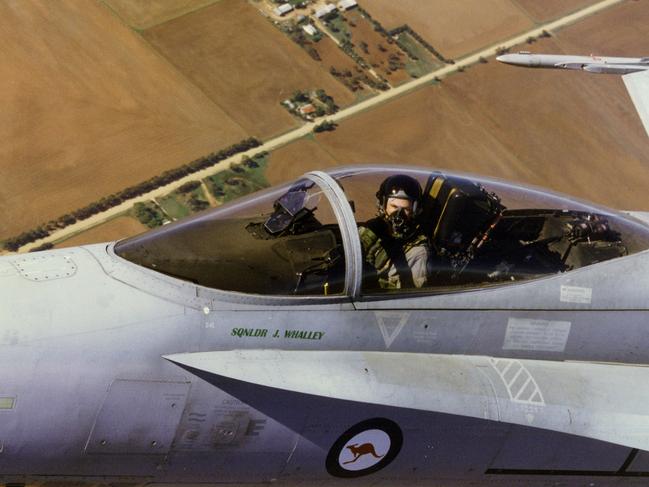
If there is a link between flying and business, it’s in the planning.
He says for every hour of flying he did as a test pilot, there would need to be 20 hours of planning and preparation beforehand.
Whalley also had stints at the Empire Test Pilots’ School in England, where he flew all sorts of aircraft, including Harriers and Tornadoes, and was squadron leader at the Aircraft Research and Development Unit in Australia before deciding his time was up.
For a long time he had nurtured an ambition to be chief of the air force, but a couple of things happened along the way.
First, he met Melinda O’Leary. Whalley and his first wife had split when he returned from England. It was, he says, amicable but she wanted to stay in England and he wanted to keep flying planes in Australia.
A year after the split he met Melinda, who had three children from her first marriage, and that meant he would be moving to Adelaide if they were to be together. “Then it all got a bit serious with Melinda. Obviously I was a young, good-looking fighter pilot so she pursued me relentlessly ... well, that’s my story,” Whalley says with a broad smile.
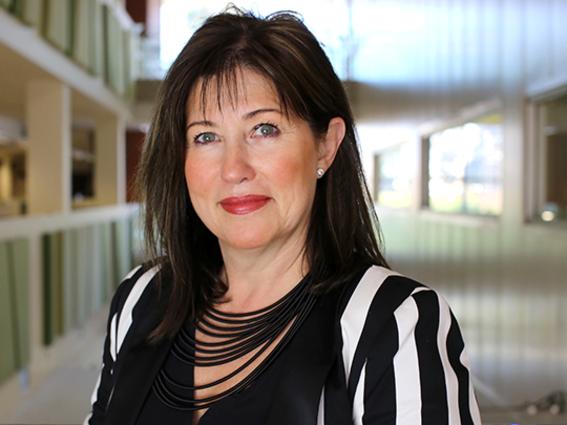
The other issue was that it was peacetime, and he was getting itchy feet. When Australia sent the air force to Iraq in 2002, it was the first time in 50 years that it had sent fighter pilots to war. Leaving the air force before experiencing combat leaves Whalley with mixed feelings.
“I don’t think fighter pilots want to be involved in war, but you train for something,” he says. “It’s like a footy game; you just want to see how you would react.”
His godfather would take him to meet old pilots who fought in the war. They would tell him stories of taking on superior Japanese Zeros. Whalley has great respect for those fighters. They were risking their lives every time they went up.
He left the air force in July 2000 for the more uncertain world of private enterprise. Nova’s first job was in the United Kingdom but Whalley says those first three years were difficult. He admits he and Peter Nikoloff were fortunate their respective wives were better business people than they were and would offer advice and support.
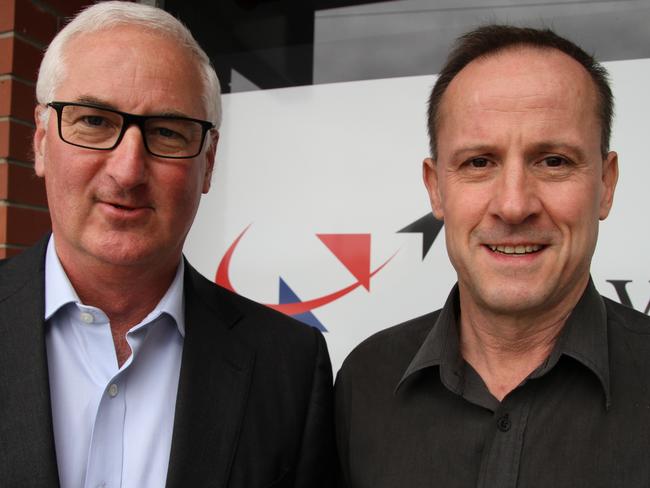
Nova’s first office was an old guard’s house at the Defence Science and Technology Organisation at Edinburgh that hadn’t been used for 40 years. They appropriated some carpet for the office when a friendly defence type said he would “accidentally” leave open a door in another building that was about to be demolished.
All Nova’s early work was in the defence sector. And most of it still is. In a broad sense, the company goes in to an organisation, such as the air force, and makes sure new equipment works as it should and verifies it meets the contract requirements. This means going through a lot of flight manuals and performance manuals to make sure all is as it seems. Or Nova can offer advice on the specifications an organisation needs when buying something new or competing for a tender. At the moment, Nova is doing a lot of work in Europe advising how aircraft can be adapted to carry COVID-19 patients.
“The first three years it was always touch and go,” Whalley says.
He kept flying for the air force reserve to bring some income in and kept open the option of going back to the force as a fall back. Whalley was also qualified to join a commercial airline, but that didn’t appeal. He sold his house to put the money into the business. He and Nikoloff would drive to Canberra looking for business, because they couldn’t afford to fly.
But the company started to expand. After a year they hired their first employee. And the work started to come in. Now Nova also operates in the UK, Ireland, Norway, Singapore and New Zealand.
And Whalley wants it to keep growing – and not just because of his “desire for world domination”.
“I think to have a company that solves some of the really big problems, you need to have magnitude, you need to have scale, so you can marshal all those disparate technologies and expertise together to actually solve quite complex problems,” he says.
Another reason is to build a company that can attract young South Australians. He and Melinda have six children and Whalley has watched too many young people leave the state to chase their careers.
“I don’t want to see our best and brightest say there are no opportunities in Australia – ‘I’m off to work for NASA’ or ‘I am going off to work for ESA (European Space Agency) or Airbus or Boeing’,” he says. “We should have companies and opportunities in Australia to do that sort of work.”

Which is what also attracted him to take on the role of the state’s inaugural chief entrepreneur, a role which sees him as a champion for the state’s start-up sector and providing advice to Premier Steven Marshall on how best to encourage innovation. It’s a job he does for free, even though he estimates he works on it about four days a week.
He’s naturally excited about Lot Fourteen in the city and the Australian Space Agency.
“I want my son, who is at Adelaide Uni, to be walking past Lot Fourteen to be saying, ‘I am going to work there one day; I am going to be launching satellites.’ Or, ‘I am going to be designing propulsion systems that will get us to the moon, then to Mars and beyond. And I am going to do this right the in the city I love.’”
One of Whalley’s ambitions is to close the gap between innovation and technology, which he says we are good at, and commercialisation, which he says we are really bad at. He says as a society we have not had the motivation to bridge that gap. That we have relied for too long on sectors such as mining and agriculture to haul the country along.
“I don’t think there has been that real driving force in our society,” he says. “People talk about creating an entrepreneurial spirit like Israel. But until we arm New Zealand and Tasmania with nuclear weapons you are not going to have that existential threat.”
If we don’t improve, he says, children will have a poorer standard of living than their parents. The threat posed by the coronavirus to the economy and business, he believes, will be devastating to some start-ups and young companies.
“There is no doubt companies will fail,” Whalley says.
“That is a real tragedy for people who have invested their time, and their efforts, and their money and, often, their mortgages,” he says. “We have not had a crisis like this since, arguably, the Second World War or the Depression.”
He says companies exposed to tourism or hospitality will be hit hardest, and that other businesses will suffer cash flow problems because their customers can no longer pay their bills. Other start-ups who are chasing funding from venture capitalists are facing a tough time. But he believes businesses in sectors such as cyber and defence could do well.
Whalley thinks state and federal governments have done well in handling the virus and the “eternal optimist” in him believes we will be OK in the long run.
He also wants to create the concept of the entrepreneur as a “hero”. Whalley knows most see businesspeople as being driven mainly by self-interest and understands to change that narrative they must “behave ethically”. “It’s not creating a $20 billion-a-year or a $100 billion-a-year company and then deciding to start up a foundation after you have screwed everyone over on the way up there. It’s making it part of the DNA.”
Despite Whalley’s hectic life, there is still time to fly. He has a variety of aircraft in a couple of sheds in the Hills near Woodside. He had a narrow escape in the December bushfires, which burnt all the way up to the sheds, leaving them singed but not damaged. He has a couple of Gazelle helicopters, one of which led British forces into Iraq. There is the Chipmunk, which was used for a long time as an air force trainer. Elsewhere he has an ex-Singapore air force Marchetti S211 jet, which is fast enough to give an old Hornet pilot a bit of a thrill.
“Whilst it doesn’t go as fast as a Hornet, you still get 6G out of that,” he says. “You put on a G-suit, you get the same sort of feeling. That will do 400 knots (740km/h), so that’s pretty good.” Although it’s still being repaired, after an engine failure last year saw him land it in a paddock.
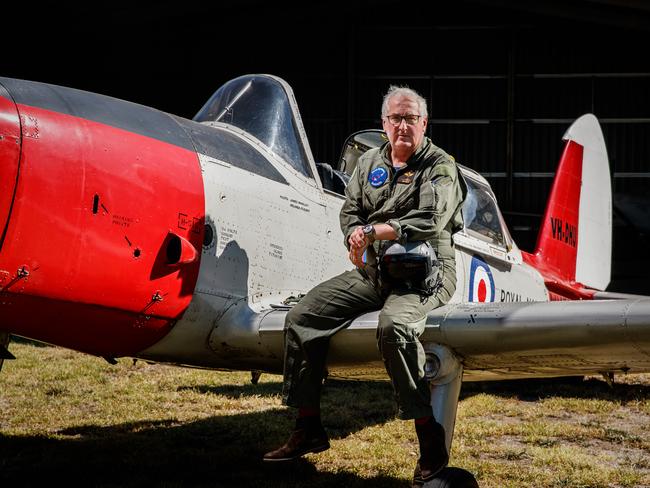
Still, he nominates his World War II-era Boomerang as the scariest plane he has flown. The Boomerang was an Australian-designed and built fighter and the one he flies is the very one his father used to sit in during the war. It was damaged in a 1943 landing on a beach by another pilot and left to rot.
Years later, several downed aircraft were recovered from the area, including the one flown by Flight Lieutenant Alan Whalley. A long restoration job later and Jim Whalley flies the Boomerang, often at air shows and on occasions such as Anzac Day.
But it’s not easy. He estimates it has between 20 per cent and 30 per cent of its original parts. “I reckon my pulse goes up every time I fly,” Whalley says. “Just because the handling of it is not good. It’s a 70-year-old engine in design. And you are just constantly waiting for something to go wrong. So you are constantly on edge.”
Like the day the brakes failed on landing.
“It was like going down a freeway at 150km/h without any steering or brakes,” he says. “It’s like driving an old car – the brakes aren’t that great, the handling isn’t that great, but it’s still a piece of Australian history.”
